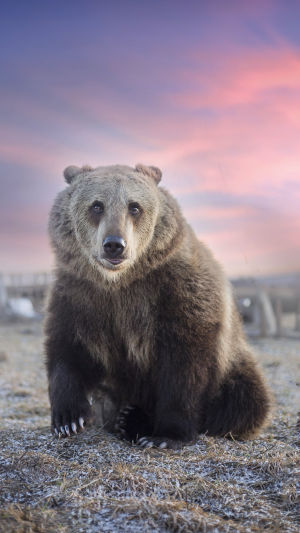When it comes to the Gobi Desert, many people may think of a barren desert. But this is not all about the Gobi Desert.
In such an environment, there is actually a strong and fragile ecosystem. The scattered oases support many animals, such as marmots, Gobi argali, wild camels, snow leopards, and the world's most endangered brown bear - the Ursus arctos gobiensis.
The Ursus Arctos Gobiensis is called "Mazaalai" in Mongolian and is the "national bear" of Mongolia. It is a subspecies of the brown bear.
There were only more than 20 individuals left before, and they only lived in the Great Gobi Protected Area (GGSPAA) in southwestern Mongolia. They have a single diet and secretive temperament, and scientists are still trying to understand them.
Strong and Fragile Gobi Desert
The Gobi Desert in Mongolia is the fifth largest desert in the world. The word "Gobi" also comes from the Mongolian "Говь", which means desert or gravel desert.
The temperature range here is extremely large, reaching minus 40 degrees Celsius in winter and 40 degrees Celsius in summer. The annual precipitation is only 190 millimeters, which is only equivalent to the 24-hour rainfall of a heavy rainstorm.
In such a barren environment, it is the scattered oasis complexes that support the ecosystem of the Gobi Desert. These areas are often distributed with surface water, which nourishes the plants, and animals follow them, looking for food and drinking water here.
Ursus Arctos Gobiensis mainly feed on plants in the oasis, however, their single diet also makes them particularly vulnerable to environmental damage. If the Gobi desert becomes drier and there are fewer plants to eat, they will face the threat of starvation.
Since the 1970s, the distribution range of Ursus Arctos Gobiensis has shrunk by 60% due to factors such as intensified competition for water sources and the expansion of human activities. In addition to this, they are also threatened by poaching and illegal mining.
In order to protect Ursus Arctos Gobiensis and other wild animals, Mongolia has set up "strict nature reserves". Since 1985, Mongolia has provided food for Ursus Arctos Gobiensis in spring and autumn, including wheat, corn, carrots, and turnips.
Scientists also set up cameras and collect hair at feeding points to understand the population composition of Ursus Arctos Gobiensis. In 2009, scientists found only 21 individuals. And by 2021, this number will finally rise to 51.
Despite this, Ursus Arctos Gobiensis have still been classified as Critically Endangered (CR) species on the IUCN Red List.
Ursus Arctos Gobiensis have been better protected, and surveys over the past ten years have shown that the population is on the rise. However, their future is still not optimistic.
First of all, the population of Ursus Arctos Gobiensis is still too small, the most optimistic estimate is less than 100, and the genetic diversity is too low.
On the vast Gobi Desert, the extremely low population density of Ursus Arctos Gobiensis also means that it may be difficult for individuals to find a mate during the estrus period. Also, of the 51 known individuals, only 15 are females.
Scientists initially suspected that differences in the range and patterns of activity between the sexes might have made females more likely to be missed by surveys. However, after combining various survey methods for statistics, they ruled out this possibility.
Like so many other species, Ursus Arctos Gobiensis are affected by climate change. As the environment in the Gobi desert becomes harsher, with rising temperatures and less precipitation, Ursus Arctos Gobiensis will face the threat of food shortages.
Climate change will also lead to more frequent occurrences of local extreme weather events. For such a small population that is only distributed in a specific area, a meteorological disaster is enough to bring disaster to the entire species.





